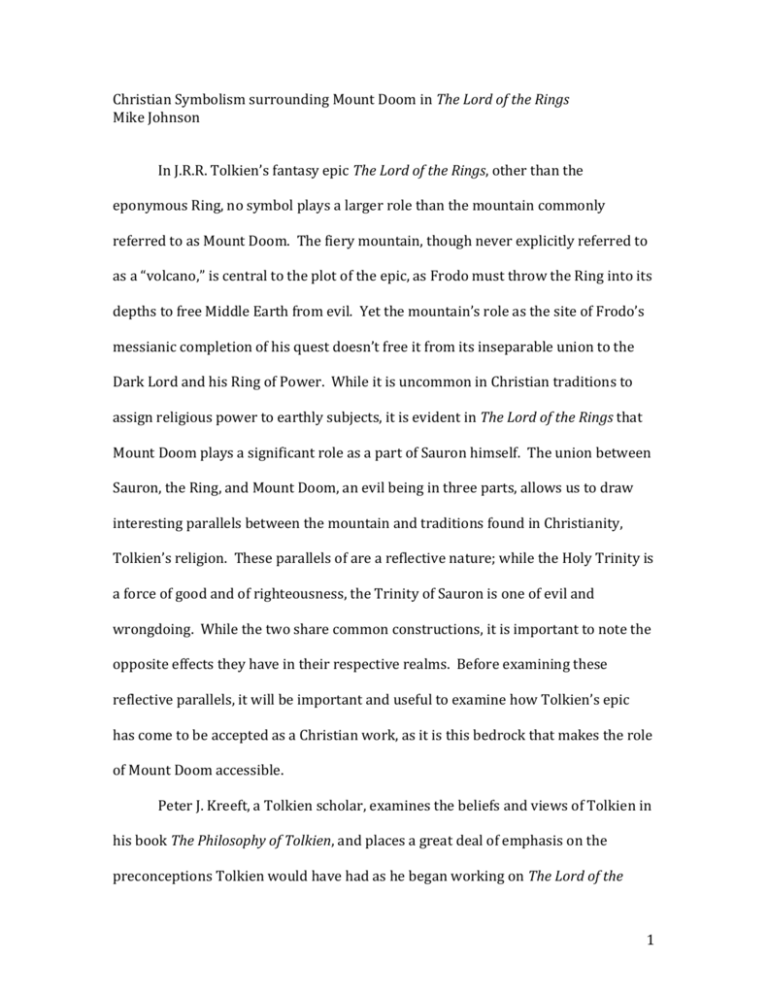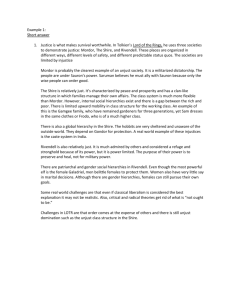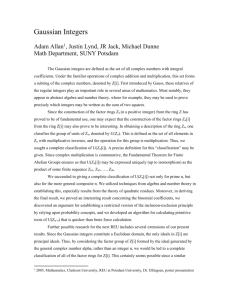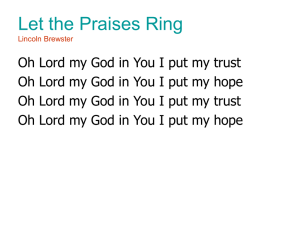Mount Doom Final
advertisement

Christian Symbolism surrounding Mount Doom in The Lord of the Rings Mike Johnson In J.R.R. Tolkien’s fantasy epic The Lord of the Rings, other than the eponymous Ring, no symbol plays a larger role than the mountain commonly referred to as Mount Doom. The fiery mountain, though never explicitly referred to as a “volcano,” is central to the plot of the epic, as Frodo must throw the Ring into its depths to free Middle Earth from evil. Yet the mountain’s role as the site of Frodo’s messianic completion of his quest doesn’t free it from its inseparable union to the Dark Lord and his Ring of Power. While it is uncommon in Christian traditions to assign religious power to earthly subjects, it is evident in The Lord of the Rings that Mount Doom plays a significant role as a part of Sauron himself. The union between Sauron, the Ring, and Mount Doom, an evil being in three parts, allows us to draw interesting parallels between the mountain and traditions found in Christianity, Tolkien’s religion. These parallels of are a reflective nature; while the Holy Trinity is a force of good and of righteousness, the Trinity of Sauron is one of evil and wrongdoing. While the two share common constructions, it is important to note the opposite effects they have in their respective realms. Before examining these reflective parallels, it will be important and useful to examine how Tolkien’s epic has come to be accepted as a Christian work, as it is this bedrock that makes the role of Mount Doom accessible. Peter J. Kreeft, a Tolkien scholar, examines the beliefs and views of Tolkien in his book The Philosophy of Tolkien, and places a great deal of emphasis on the preconceptions Tolkien would have had as he began working on The Lord of the 1 Rings. As Kreeft writes of Tolkien, “his philosophy could not possibly be excluded from his life’s work” (Kreeft, 12). Knowing, then, that Tolkien was a devout Christian, allows for interpretations of his work along those lines. There permeates throughout the epic a sense of the divine providence and fate found in Christianity. As Frodo and Gandalf talk over the Ring, Frodo despairs over the events that led him to bearing it. Gandalf sees in the events “something else at work, beyond any design of the Ring-maker… In which case you were also meant to have it” (Tolkien, FotR, 81). Gandalf’s “sensing” of this “something else” at work implies the existence of a higher power, orchestrating the events of the age. The passage of the Ring from Bilbo to Frodo is one of only two willful surrenders of the Ring in its roughly fivethousand-year history. That Bilbo found the Ring enables the monumental act of surrender, which, of course, causes the Ring to be destroyed in the end. The Providence that seems evidenced by Bilbo’s very finding of the Ring is met by the causative power of his willful surrender of it. Yet as C.S. Lewis notes, in Christianity, “’Providence’ and Natural causation are not alternative; both determine every event” (Kreeft, 61). In these small ways, the issue of divinity becomes evident in Tolkien’s world. It is not overt, but instead prefers to reside outside the realm of the living, governing events through providence. While this in itself does not ensure that Tolkien’s world is a Christian world, themes are evident in the texts to support that conclusion. This divine detachment is what makes Sauron so unnatural and evil; he desires to be a God in Middle Earth. By forging his Ring and wielding his power to control and 2 possess Men and Elves, Sauron desires total rule, to usurp heaven. It is in Sauron that the symbolism becomes complete. Tolkien’s Silmarillion lays out the creation myths and back-story to the lands of Middle Earth, and in it, one cannot miss the similarities to the story of Lucifer’s fall. In the beginning, the world was created by Ilúvatar, who bestowed upon his angels, the Valar, powers over the various aspects of his creation (Tolkien, Sil., 18). Morgoth, the mightiest of the Valar, soon fell out of disfavor because his jealousy of the other Valar, and desired power and control of Ilúvatar’s creations (Tolkien, Sil., 4). During the creation of the world, Morgoth sought to “bring into Being things of his own,” and to usurp the creative power of Ilúvatar (Tolkien, Sil., 4). This jealousy and desire to have “things of his own” matches the character of Satan in the Christian tradition, who, in the Book of Revelation, is revealed to be the serpent from the Garden of Eden (Revelation, 20:2). Morgoth even has a battle with the other Valar, seeking to overthrow them and to rule as a God over Middle Earth, but is defeated, and cast into the Void (Tolkien, Sil., 315), much as Satan is locked away following his defeat at the hands of Michael (Revelation, 20:2). Yet Morgoth’s powers of deception are said to be “a seed that does not die and cannot be destroyed, and ever and anon it sprouts anew” (Tolkien, Sil., 315-16). Similarly, God realizes that the serpent’s temptation of Adam and Eve will persist, and he casts them from Eden, lest they “take also from the tree of life and eat, and live forever” (Genesis, 3:23). But Morgoth is not Sauron. Sauron is a Maiar, a lesser angel, and all of the Valar had Maiar assigned to them by Ilúvatar. Morgoth corrupts the Maiar Sauron, 3 much in the same way the serpent corrupts Eve, and pulls him away from his Valar (Tolkien, Sil., 329). Sauron, after the fall of Morgoth to the rest of the Valar, rises “like a shadow of Morgoth and a ghost of his malice,” and walks “behind him on the same ruinous path down into the Void” (Tolkien, Sil., 26). Sauron, the disciple, seeks to regain the power of Morgoth, and “he determined to make himself master of all things in Middle Earth… and he named himself Lord of the Earth” (Tolkien, Sil., 358). Sauron fills the role left by the banished Morgoth, and serves the antagonistic legacy that Morgoth leaves behind. In Christianity, and in Middle Earth, the powers of righteousness do not dwell in the physical world. The Valar and Ilúvatar are not present, while Sauron is; the Valar live in the Undying lands to the West, while Ilúvatar never resided on the earth. Sauron’s ease at corrupting Men demonstrates the innate tendency to lust for power seen in Christianity, which in that religion is combated by faith in God. Faith, and proper following of God (or in the case of Middle Earth, good) depend on the rejection of the temptations of Satan (or Sauron). In the Bible, Job’s unwavering faith is defined in terms of his resistance to the temptations of Satan (Job 42:10). In The Lord of the Rings, Bilbo’s resistance to hold onto the Ring eventually defeats Sauron. Furthermore, all the characters that resist the temptation of the Ring— Aragorn (FOTR), Bilbo (FOTR), Frodo, Galadriel (FOTR), Faramir (TT), Gandalf (FOTR), and Sam (ROTK)— are ”saved” in the end, or in the ethics of Middle Earth, survive in the post-Sauron Age. If Sauron wished to become a god among men, and to become the “Lord of the Earth,” then in the novels as set down by Tolkien, he succeeds. There exists in 4 the story of Sauron an intriguing parallel to the concept in Christianity of the Holy Trinity, a God in three parts. This tenet holds that Jesus, the Son of God, actually is God incarnate, and that the Holy Spirit, the force that allows the grace of God to touch man, is God’s Spirit on Earth. There is a similar construction of Sauron, the Ring, and Mount Doom. Throughout The Lord of the Rings and The Silmarillion, the phrases “One Ring” or “Ring” are always capitalized, similar to the capitalization of all references to God, including pronouns. This leads to an elevation of the Ring over simple objects, and up to the level of Sauron, its creator. Even the title of the epic can be seen as reinforcing a unity between Sauron and the Ring. The saga is named The Lord of the Rings, but it is unclear who that “Lord” is. In one sense, Sauron is the Lord of the Rings, as he fashions the One Ring in order “to rule all the others” (Tolkien, Sil., 356). However, it is only through wielding the One Ring that he is granted this power, and so it could be construed that the Ring itself is the Lord of the Rings. The inscription on the Ring’s band reads, “One Ring to rule them all, One Ring to find them, One Ring to bring them all and and in the darkness bind them” (Tolkien, FotR, 75). In essence, both are true. The Ring does not grant control of the rings to just anyone; when Frodo puts it on, he merely becomes invisible, whereas Sauron is the only one who can unleash the ultimate power of the Ring (Tolkien, FotR, 201). The Ring and Sauron are both Lord of the Rings: singular, because they are one. The Ring has no beginning and no end, much like the eternal, infinite God of Christianity. Sauron, wanting immortality and to possess infinity, crafts the Ring in the fiery forge of Mount Doom, and “much of the strength and will of Sauron passed into that One Ring” (Tolkien, Sil., 356). When at 5 the end of the Second Age, Isildur cuts the Ring from Sauron’s hand, Sauron is vanquished, and forsakes his body, severed as he is from his own essence, embodied in the Ring (Tolkien, Sil., 365). This union is made explicit in Peter Jackson’s film adaptation, as Gandalf plainly states, “they are one, the Ring and the Dark Lord” (FOTR). There exists another parallel between The Lord of the Rings and Christianity, but it finds its roots in Greek myth, which Pamela Frierson notes “Christianity struggled mightily against” (Frierson, 87-88). The Greek god Hephaestus lived and worked in the bowels of Mount Etna. (It is important to note that in the Roman Pantheon, he became the god Vulcan, from which the term “volcano” is derived.) The deformed Hephaestus was married to the Greek goddess of beauty, Aphrodite, a symbolism that is not lost on Frierson. As she explains, “His [Hephaestus’s] relationship with Aphrodite suggests a strong link between the creative power of fire and the procreative power of sex” (Frierson, 88). This link is intriguing, because in it exists a link between Sauron and the Christian God. As Sauron forges his Ring of Power, he is creating a thing with “a will of its own” (FOTR). He does this in a volcano, a place immortalized by Hephaestus as a creative workshop. God, on the other hand, sends Jesus to the earth via natural childbirth, utilizing the procreative power of human reproduction. There is a reflective similarity even in the location of the creation and procreation exhibited by Sauron and God, as Frierson describes “Hephaestus’s transformative work takes place within the fiery womb of the volcano” (Frierson, 88). Sauron creates his Ring in the womb of Mount Doom, while God procreates Jesus within the womb of the Virgin Mary. 6 While Frierson admits that Christians “tended to deny nature an immanence of its own,” she continues, “Christian mystics hinted that the earth itself might be part of the body of God” (Frierson, 88). There exists then, in early Christian teachings, an earth that can be seen as a part of God, strengthening the reflective similarity between Sauron and the Christian God. In later Christian tradition, especially in the Book of Revelation, Frierson notes that once Satan is cast into a “lake of burning sulfur,” (Revelation 20:10) he becomes the ruler of that lake, and in him “we find the ghost of the mythic Hephaestus-Vulcan at his forge” (Frierson, 89). The mountain, then, becomes the third part in this unholy Trinity. The mountain, called Orodruin by the Elves, commonly referred to as Mount Doom, is the favored place for Sauron to build his fortress, because of its volcanic properties. As the Silmarillion explains, “indeed for that reason Sauron had set there his dwelling long before, for he used the fire that welled there from the heart of the earth in his sorceries and in his forging” (Tolkien, Sil., 363). Sauron, the shadowy reflection of God, the Maiar who wishes to usurp Ilúvatar, selects for his fortress a volcano, a mountain with its roots in “the heart of the earth.” It is extremely fitting, as Sauron tries to capture the primal forces of the land to which he is bound in order to usurp heaven. The mountain is inexorably linked to Sauron, as it is the mountain’s fire that alerts the kingdoms of men to his return at both the end of the Second and Third Ages (Tolkien, Sil., 363). The mountain becomes an entity, filled with an emotion and spirit of its own, which reflects that of Sauron himself. Not simply consigned to signaling the presence of Sauron and serving him as a forge, the mountain exhibits Sauron’s 7 exultation, fury, and menace. In the New Line Cinema adaptations of The Lord of the Rings, director Peter Jackson demonstrates these qualities of the mountain accurately. In the beginning stages of the movie, the creature Gollum is tortured to reveal the whereabouts of the Ring. Within Sauron’s fortress of Barad-Dûr, Gollum screams “Shire! Baggins!” (FOTR) The camera cuts immediately to a shot of the mountain, which erupts violently in exultation at the news; Sauron knows the location of the Ring (Fig. 1, FOTR). This imagery is clearly meant to show Sauron’s intense pleasure at discovering the whereabouts of the One Ring; he instantly sends out the Nazgûl to recover the ring, and as Saruman tells Gandalf, “kill the one who carries it” (FOTR). The mountain’s role in the scene is not merely a poetic substitution for Sauron’s phallus, but instead fuels the very fortress in which Gollum is being tortured. The 8 lava stream running from Mount Doom pours down into the forges of industry, powering the Dark Lord’s machinery (FOTR). Lava, the fiery substance that Mount Doom draws from “the heart of the earth,” becomes analogous to the molten iron used in forges, as Sauron draws on the power of the very earth to drive his ambition. The mountain, then, serves not only as an extension of Sauron’s ego but as its powering force as well. Sauron could not exist without the mountain. The mountain is a physical extension of Sauron, who, in The Lord of the Rings, has no physical form. Its eruptions show his emotions when he has no face, and its ash shows his reach when he has no arms. As Gandalf rushes to Minas Tirith, the citadel of the race of Men, to determine the true identity of the Ring, he pauses on a ridge to see the menacing ash cloud hanging over the pearly white city. (Fig. 2, FOTR) Over the ridge of mountains, lava spews upward into the dark cloud of ash as Sauron readies his army. The towering mountains of white in the foreground contrast sharply with the pitch-black mountains of slag that ring the land of Mordor. 9 There is even a noticeable barrier between the white light reflecting off the walls of Minas Tirith and the ash cloud of Mount Doom; the city seems to radiate light to combat the ever-encroaching reach of Sauron. Gandalf’s reaction of shock shows the viewer that this is a new, and dangerous, development. The eruptions of the volcano seem to say to the people of Middle Earth, “I’m coming,” and essentially dare them to try to resist. The ever-encroaching ash cloud extends the reach of Sauron over the ruined city of Osgiliath, the site of the battle between orcs and men since Sauron’s fall at the end of the Second Age. Yet the ash cloud now extends as Sauron returns and pushes his spirit forward; the ash and fire of the volcano are his will to dominate. This motif recurs throughout the films, especially during the third film, when the garrison at the ruins of Osgiliath falls, and the men of Gondor are forced to retreat before the hordes of Sauron. Gandalf, 10 covering the retreat, rides out to meet them, and to force back the Nazgûl who threaten to decimate the retreating lines. The men ride out from under the shadow of Sauron’s ashen reach, as Gandalf’s white light beats back the dark riders (Fig. 3, ROTK). Again, we see Sauron’s arm reaching out to grab the fleeing army, and it appears he is going to succeed, until Gandalf rides out and battles the encroaching darkness with his light. After the battle of Minas Tirith, when the armies of Mordor have been seemingly defeated, light shines down once more through the ash cloud, which begins to recede into the dark lands that Sauron still controls. When the Ring is finally destroyed, Mount Doom has one final, cataclysmic eruption, expelling all of the evil that it has held within for the length of the Age, and the Trinity— Sauron, the Ring, and Mount Doom, are vanquished together (Fig. 4, ROTK). It is only when the three are united for the second time (the first being when Sauron forged the Ring inside the fiery mountain) that evil can be expelled entirely from Middle Earth. When Islidur cut the Ring from Sauron’s hand, Sauron’s physical form was defeated, but the Ring remained, so Sauron lived on. This second meeting 11 of the Trinity in Lord of the Rings is not unlike the cataclysm at the end of Revelation, with the second coming of Christ. As the Ring returns a second time to the fires of Mount Doom, evil is swallowed whole, as the very ground opens underneath the fleeing orcs (FOTR). Similarly, the Earth opens in Revelation, and Babylon is destroyed by God’s wrath (Revelation 16:19). As the Second Coming rids the world of evil, so does the second meeting of Sauron, the Ring, and Mount Doom. While the result is the same, the cause is dissimilar, matching the reflective nature between the Holy Trinity and the Trinity of Sauron. The Second Coming is a unifying, generative process. The world is rebuilt, and the righteous rule from the New Jerusalem (Revelation 21:2). The second meeting of the Trinity of Sauron is a destructive process. The Ring is unmade as it meets the fires of Mount Doom, which destroys Sauron. The lack of Sauron’s presence in the world is what enables the people of Middle Earth to live free from fear. Tolkien’s fantasy epic The Lord of the Rings is a covertly Christian work; as Kreeft proves, it is impossible for it to be anything else. In this epic, Mount Doom 12 represents the spirit and power of the Dark Lord Sauron. Together with Sauron himself and the One Ring, they constitute a Trinity in the lands of Middle Earth. The three are actually one: Sauron’s power is in the Ring, and his emotions and spirit are in Mount Doom. The film adaptations demonstrate this visually, as we see the mountain erupting triumphantly when Sauron is pleased (Fig. 1), burning hotter when his forges are at work, reaching out to cover the lands in darkness (Figs. 2-3), and erupting climactically and cataclysmically when Sauron is destroyed (Fig. 4). Sauron, Tolkien’s Satan, fulfills the role of antagonist to the forces of good in Middle Earth, who without being overtly Christian demonstrate honor, valor, and to some extent, righteousness. The shadowy Trinity hearkens to the primal forces of the earth and of men, and to the early foundations of theodicy, but nonetheless the reflection of the Holy Trinity is there, as though they are two sides of the surface of a lake. To each, the other is blurred and not quite real; they are copies, yet opposites. Smeagol/Gollum: a shadowy reflection (Fig. 5, TT) 13 Bibliography Frierson, Pamela. The Burning Island: A journey through myth and history in volcano country, Hawai'i. San Francisco: Sierra Club Books, 1991. Kreeft, Peter J. The Philosophy of Tolkien. San Francisco: Ignatius Press, 2005. Tolkien, J.R.R. The Lord of the Rings: The Fellowship of the Ring. New York: Ballantine Books, 1965. —. The Lord of the Rings: The Return of the King. New York: Ballantine Books, 1965. —. The Lord of the Rings: The Two Towers. New York: Ballantine Books, 1965. —. The Silmarillion. New York: Ballantine Books, 1977. The Lord of the Rings: The Fellowship of the Ring. Dir. Peter Jackson. Perf. Elijah Wood, Ian McKellen, Viggo Mortensen, Sean Astin. New Line Cinema, 2001. (Cited as FOTR) The Lord of the Rings: The Two Towers. Dir. Peter Jackson. Perf. Elijah Wood, Ian McKellan, Viggo Mortensen, Sean Astin. New Line Cinema, 2002. (Cited as TT) 14 The Lord of the Rings: The Return of the King. Dir. Peter Jackson. Perf. Elijah Wood, Ian McKellan, Viggo Mortensen, Sean Astin. New Line Cinema, 2003. (Cited as ROTK) The Holy Bible: New International Version. Biblica, 1984. (accessed online via http://www.biblegateway.com/) 15








